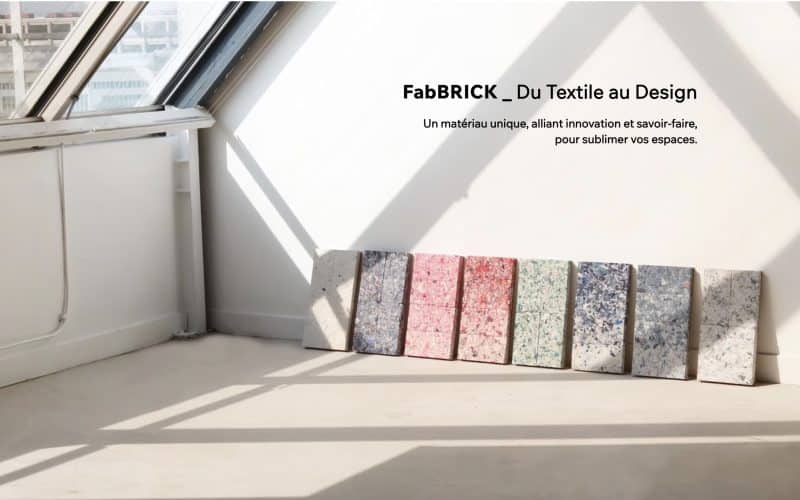
If we see an innovative idea, we will report on it. And this start-up is one for sure: FabBRICK, a French company that turns textile waste into bricks.
We are literally drowning in textile waste, mostly generated by fast fashion. Add to that the increasing awareness of the environmental impact of construction, and then you have FabBRICK which emerges as a rare synthesis of innovation, sustainability, and practical design.
This Paris-based design studio, founded in 2019 by architect Clarisse Merlet, transforms discarded clothing into stylish, modular bricks. The concept is deceptively simple: upcycle what we throw away into something that builds our future.
Let’s take a closer look at how Merlet operates.
A Solution to Two Crises
The fashion industry generates over 92 million tonnes of textile waste globally each year, most of which ends up in landfills or incinerators. At the same time, the construction sector consumes massive natural resources and contributes to nearly 39% of global CO₂ emissions. FabBRICK tackles both issues head-on by collecting shredded textile waste – mostly cotton and polyester – and converting it into a building material.
Each FabBRICK unit uses 2 to 4 old T-shirts, reshaped with an eco-friendly, proprietary bio-based glue. Unlike traditional bricks, they require no heat, water, or chemical treatments. The bricks are naturally dried over 10 to 15 days and don’t need any artificial coloring – the hues come directly from the original fabric.
How It Works
The production process starts with sorting textile waste by fiber type and color. These are then shredded into small fibers. Next comes the proprietary binding process. A bio-based glue – formulated in-house and kept under wraps – is added to the fibers. The mix is compressed into custom molds and left to air-dry. No kiln, no chemical fumes, no high-carbon footprint.
As Merlet explained in an interview with DesignWanted: “We wanted to create a material that would be both useful and beautiful, one that addresses real environmental problems while offering creative freedom.”
Properties and Performance
The resulting bricks are lightweight, thermally insulating, and provide acoustic dampening. They’re also fire-resistant – an essential feature for interior architecture. What they’re not yet, however, is load-bearing. That limits their use to interior designs, decorative features, and light partition walls, but this hasn’t slowed demand.
Companies like Guerlain, Vinci, and Leroy Merlin have already partnered with FabBRICK to integrate the material into pop-up stores, office furnishings, and temporary event booths. Designers prize the bricks for their organic texture and customizable palette, making them ideal for both functional and aesthetic uses.
So far, the main applications include:
- Acoustic panels in open-plan offices
- Modular furniture like shelves and stools
- Lightweight partition walls in co-working spaces
- Sustainable displays for retail pop-ups
Each use case reduces the environmental load while introducing a tactile and visual uniqueness that other sustainable materials often lack.
What Sets It Apart
Let’s break it down:
| Feature | FabBRICK | Traditional Brick |
|---|---|---|
| Raw material | Textile waste | Clay, sand, cement |
| Energy use | No ovens or kilns | High heat required |
| Water use | None | High (especially in concrete) |
| Emissions | Very low | High CO₂ footprint |
| Custom colors |
The Aesthetic Advantage
Because the colors of the bricks come directly from the original garments, no two bricks are ever identical. This gives interior designers and architects quite some creative flexibility. From monochrome panels to speckled mosaics, the design possibilities are nearly endless.
As Merlet puts it: “We don’t just want to be green – we want to be gorgeous.”
This approach – sustainability that doesn’t sacrifice beauty – has triggered brands trying to communicate environmental responsibility without looking dull or preachy.
Production and Scalability
FabBRICK has produced over 40,000 bricks, recycling more than 12 metric tonnes of textile waste so far, according to DesignPulp. The company currently operates from its Paris workshop, where most of the bricks are handcrafted. This artisanal process, while admirable, does raise questions about scalability.
To expand, Merlet plans to automate parts of the process and decentralize production by setting up local workshops in other regions. The idea is to collect and process textile waste near its source, reducing transport emissions and creating local employment.
“The dream is to have a micro-factory in every major city, so textile waste never leaves its region before becoming part of a new building,” she explained in a recent talk.
Limitations and Challenges
FabBRICK’s concept is revolutionary, but it’s not without flaws:
- Structural limitations: The bricks aren’t load-bearing, so they can’t replace concrete or clay bricks in foundational construction.
- Moisture sensitivity: While naturally fire-resistant, the bricks still struggle with humidity and are not suitable for exterior use.
- Scalability: Handcrafting limits output, and mass production is still in the planning phase.
Still, the potential is too big to ignore. Once waterproofing and load-bearing properties are addressed, the applications could expand into full-scale architecture.
What’s Next for FabBRICK
Research is currently underway to adapt FabBRICK bricks for humid environments and develop larger modules for prefab applications. The studio is also testing bricks using industrial textile waste, such as scraps from manufacturing lines and unsold inventory.
There’s talk of integrating other recycled materials—foam, sawdust, even shredded paper—into the mix. Combined with digital fabrication, FabBRICK could become part of a larger material innovation ecosystem.
The startup won’t replace concrete overnight. But it shows a new path – one where trash becomes texture, and waste becomes walls. For more information or to get involved, visit fab-brick.com.
